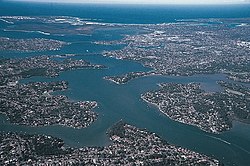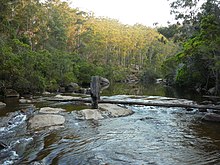
Heathcote National Park is a protected national park that is located in the southern area of Sydney, New South Wales in eastern Australia, and is situated on Dharawal country. The 2,679-hectare (6,620-acre) national park is situated approximately 35 kilometres (22 mi) southwest of the Sydney central business district, west of the Illawarra railway line, the Princes Highway and Motorway, and the suburbs of Heathcote and Waterfall.

Port Jackson, consisting of the waters of Sydney Harbour, Middle Harbour, North Harbour and the Lane Cove and Parramatta Rivers, is the ria or natural harbour of Sydney, New South Wales, Australia. The harbour is an inlet of the Tasman Sea. It is the location of the Sydney Opera House and Sydney Harbour Bridge. The location of the first European settlement and colony on the Australian mainland, Port Jackson has continued to play a key role in the history and development of Sydney.

The Airport & South Line is a suburban commuter rail line in Sydney, Australia. It connects the Sydney central business district with the southwestern suburbs via Sydney Airport. The line is part of the Sydney Trains network. The line began operating on 26 November 2017, when the T2 Airport, Inner West & South Line was split in two. Sydney Trains' predecessor CityRail operated the Airport & East Hills Line over an identical route between 2000 and 2013.

Liverpool railway station is a heritage-listed railway station located on the Main Southern line, serving the Sydney suburb of Liverpool in Australia. It is served by Sydney Trains T2 Inner West & Leppington, T3 Bankstown and T5 Cumberland services. It was added to the New South Wales State Heritage Register on 2 April 1999.

Glenfield railway station is a junction station serving the Sydney suburb of Glenfield in Australia. It is served by Sydney Trains T8 Airport & South, T2 Inner West & Leppington and T5 Cumberland line services, and by limited NSW TrainLink Southern Highlands Line services.

The East Hills railway line serves the southern and south-western suburbs of Sydney, Australia. The line opened to East Hills in 1931 and was extended to connect to the Main South Line in 1987. Most services along the line form part of the Airport & South Line operated by Sydney Trains.

Leumeah station is located on the Main Southern line, serving the Sydney suburb of Leumeah. It is served by Sydney Trains T8 Airport & South line services.
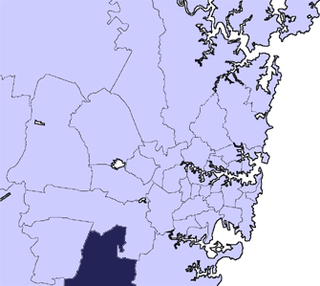
The City of Campbelltown is a local government area in the Macarthur region of south-western Sydney, in New South Wales, Australia. The area is located about 55 kilometres (34 mi) south west of the Sydney central business district and comprises 312 square kilometres (120 sq mi).

East Hills, a suburb of local government area City of Canterbury-Bankstown, is located 26 kilometres south-west of the Sydney central business district, in the state of New South Wales, Australia, and is a part of the South-western Sydney region, near larger areas like Revesby and Bankstown.
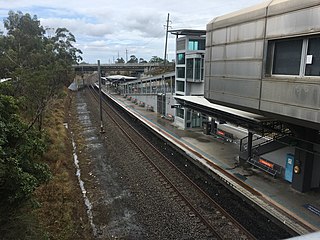
Holsworthy railway station is located on the East Hills line, serving the Sydney suburb of Holsworthy. It is served by Sydney Trains T8 Airport & South line services.

The Woronora River is a perennial river of the Sydney Basin, located in the Sutherland Shire local government area of Greater Metropolitan Sydney, approximately 22 kilometres (14 mi) south of the Sydney central business district, in New South Wales, Australia.

The Cumberland Plain, also known as Cumberland Basin, is a relatively flat region lying to the west of Sydney CBD in New South Wales, Australia. An IBRA biogeographic region, Cumberland Basin is the preferred physiographic and geological term for the low-lying plain of the Permian-Triassic Sydney Basin found between Sydney and the Blue Mountains, and it is a structural sub-basin of the Sydney Basin.
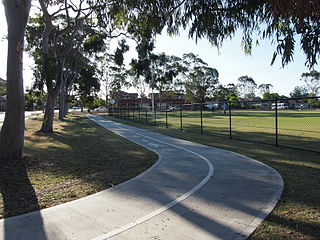
Bike paths in Sydney, New South Wales, Australia, vary widely, with the majority either shared cycle and pedestrian paths or on road paths, and a small number of separated cycleways. In 2009 the Sydney Morning Herald reported that "Sydney's cycleways are not so much an organised network as a fragmented collection of winding paths and half-finished ideas. Most were built or designed when cycling was viewed as a pleasant pastime rather than a practical form of travel and are now poorly suited to commuting."

Lugarno is a suburb situated in the St George area of southern Sydney, in the state of New South Wales, Australia. It is located in the local government area of the Georges River Council, 23 kilometres south of the Sydney central business district.

Chipping Norton Lake is a 49-hectare (120-acre) artificial lake and regional park located in the Sydney suburb of Chipping Norton, New South Wales, Australia. It is a part of the Georges River system. Chipping Norton Lake is managed by Liverpool City Council. The lake is an important recreational area for Liverpool, City of Canterbury-Bankstown and Fairfield City Council.
The Cooks River cycleway, also called the Bay to Bay Shared Pathway, is a 30-kilometre-long (19 mi) shared use path for cyclists and pedestrians in the Inner West of Sydney, New South Wales, Australia. The north-western terminus of the cycleway is in Settlers' Park, Ryde, from where it proceeds south, crossing the Parramatta River and skirting Homebush Bay to the Cooks River, from where it generally follows the course of the river south and east to the south-eastern terminus on Botany Bay at Kyeemagh. The alternative name "Bay to Bay" or "B2B" path refers to Homebush Bay and Botany Bay. The path connects a series of parklands in the City of Ryde and the Municipality of Strathfield, as well as the riverside green spaces along the course of the Cooks River.
The Holsworthy railway line was located in South-western Sydney. It was constructed during World War I, mainly using labour from the Holsworthy Internment Camp. Its purpose was to service the Holsworthy army facilities opening on 21 January 1918.

St Helen's Park is a heritage-listed former school, experimental farm, private residence and guesthouse and now homestead located at St Helens Park Drive, St Helens Park, City of Campbelltown, New South Wales, Australia. It was designed by George Allen Mansfield and built in 1887 by George Lusted. It is also known as St. Helen's Park and Egypt Farm. The property is privately owned. It was added to the New South Wales State Heritage Register on 2 April 1999.
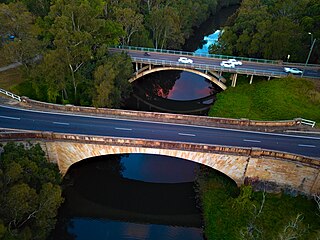
The Lennox River is the proposed name for a waterway located in Sydney's South-Western Suburbs. The existing waterway is the tidal reach of Prospect Creek, a tributary of the Georges River. A proposal has been made to upgrade and reclassify the waterway as a 'river'. The proposed river would be 6.5 kilometres (4 mi) long, starting at the confluence of Orphan School Creek and Prospect Creek at Fairfield and flowing to the Georges River emptying into Dhurawal Bay at Garrison Point.
